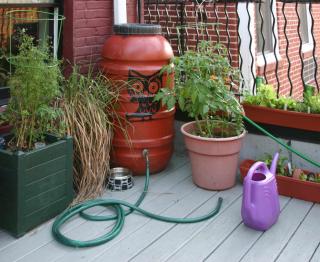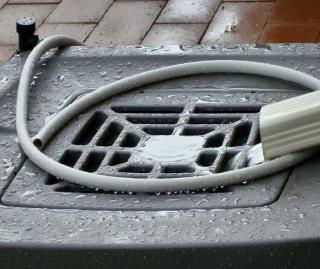

There are quite a few good reasons to look into setting up a rainwater collection system! Preserving water resources, but also saving money on the water bill, and watering your garden, balcony, terrace, cleaning your car even in times of summer water restrictions… Here is an overview of how to go about such a project.
The most convenient way to collect rainwater is to install collectors under the roof. Water runs directly from the gutters into a tank via a collector.

A simple calculation allows to know how much you can possibly recover in your setting. Multiply the roof surface that’s connected to a certain gutter by the average annual rainfall (in inches/sq foot or in mm/m²) in your area. The cistern’s volume can be determined from that, or you can choose to install several smaller models in different areas if needs or the roof configuration make more sense.
Rule of thumb for how much water storage a garden needs? You’ll need an average storage capacity of 4 gallons/yard² for the garden (15 l/m²).
A collector with a minimum capacity of 250 gallons (1,000 liters) is a good choice in most cases, especially if summer tend to be dry.
The remaining task is to choose the adequate design! Above-ground collectors are light and easy to set up, they are also much cheaper than buried models. On the other hand, buried cisterns have a much larger capacity and also allow for domestic use.
There are many rainwater collectors designs available on the market. They come in various shapes, colors, and volumes (from 50 to 500+ gallons, or 200 to 2,000 liters) that can meld in with your landscaping. Sometimes they even add a nice ornamental touch!
These large water containers can be set up near a house wall, to the side of a garden shed in the garden, or on a balcony or terrace for smaller models
→ Check with the house or building’s architect if there are any weight limits you should be mindful of… there have been cases when balconies collapse!
There are truly very beautiful options: old-fashioned wooden barrel, ancient Roman amphora, perfectly imitated wood siding, and a slew of great contemporary designer-created optios, they adapt to the style of each house.
→ Expect a price tag that ranges from 30 and 600+ dollars (30 to 500 euros) depending on volume and design.

Very large collectors hold up to 2,500 gallons of water (10,000 liters), they can be built on-site with concrete. Smaller ready-to-bury polyethylene models offer more convenience. Cleverly connected to the domestic circuit by a pump, rainwater gathered in the cistern can supply the toilet flush or domestic appliances like washing machines. Of course, it’s a near infinite supply of water for watering the garden and cleaning outdoor equipment.
→ Expect to spend between 4,500 and 10,000 dollars for a 2,500+ gallon (10,000 liters) cistern, all inclusive.